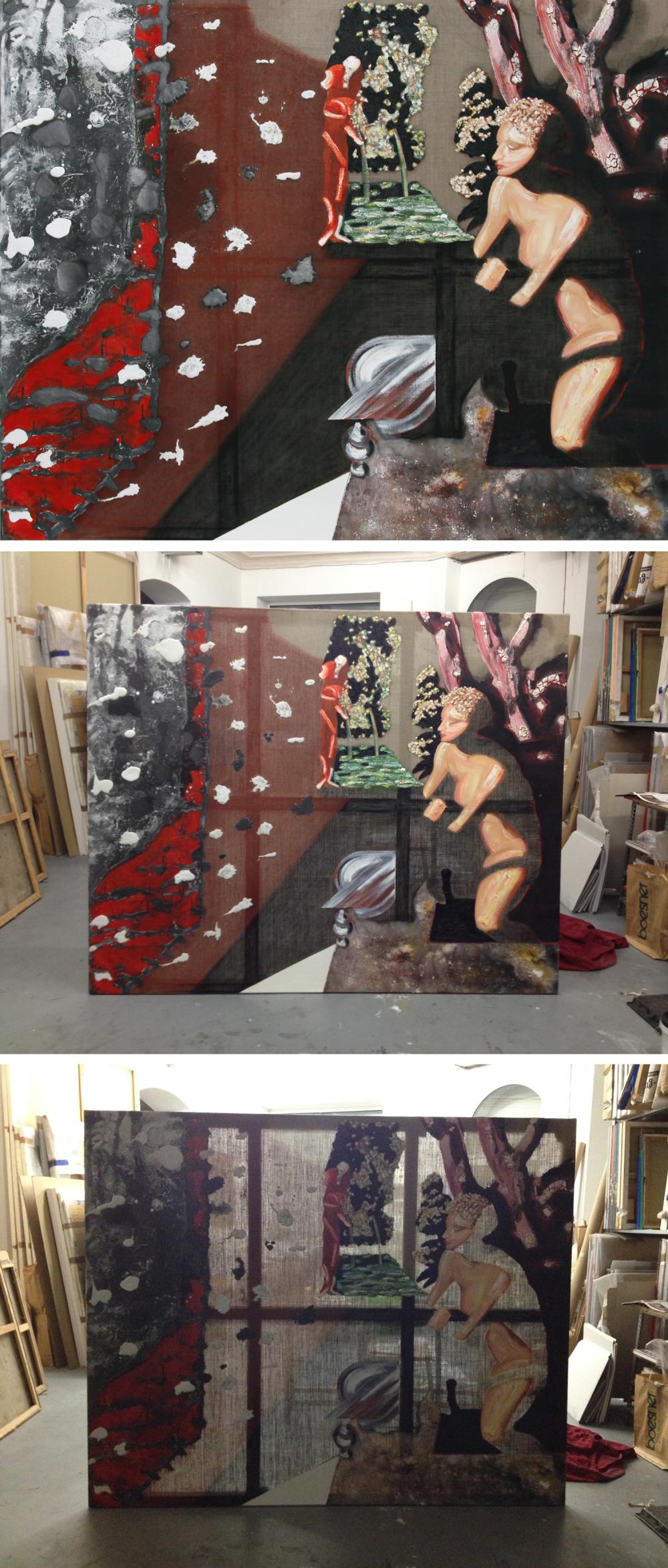Tintoretto Included / Ekaterina Tewes

„Translation of Time XVII“ is the most recent of Dybsky’s series of projects on the subject of the “Translation of Time” (the series are numbered from I to XVII so far). For all their differences, and as the shared title indicates, these series are all part of Dybsky’s ongoing exploration of painting techniques that can be used to visualize and transmit the spatiotemporal transformations of matter. The concept of transformation for Dybsky is rooted in his experience contemplating landscapes. In his decisive early paintings, he took the landscape motifs that interested him and transformed them into abstract colour formations and reliefs.
Dybsky is by no means operating on the basis of a dichotomy between abstract painting and figurative depiction seen as polar opposites. Instead, his “translation” of real motifs from the landscape into abstract paintings is best seen from a phenomenological perspective. What he translates aesthetically is not the landscape, but the act of contemplating the landscape. That process, and perception and contemplation more generally, serve him as a means of bringing temporal existence into the present. Temporality is thus the defining feature of his paintings: on the aesthetic level these works enable the visual experience of the flow of matter in space and time (like landscapes), and on the conceptual level they act as time capsules for a reflection on the historically diverse approaches to conceptualizing painting as a visual medium.
At times, the constancy of change to which matter is subject acquires material agency in his works. For the series Translation of Time XII (2004), Dybsky developed painting techniques that lead to differential aging of the different components of the picture. In time, the mirror-like perfection of the smooth surfaces begins to increasingly contrast with other parts of the picture, as craquelure and shrinkage cracking set in.
In the newest series, Translation of Time XVII, Dybsky expands his repertoire of approaches and techniques for exploring temporal and material transformation by engaging in an aesthetic reflection of the depiction and use of light in art. The spark for this series, and for Dybsky’s decision to focus on light as the transformative medium par excellence, came from his encounter with the paintings of Jacopo Tintoretto in the Scuola Grande di San Rocco in Venice. Intrigued by the inconsistencies typical of Tintoretto’s chiaroscuro, Dybsky started experimenting with techniques that make it possible to take light and shadow out of the tradition of mimetic depiction and turn them into autonomous artistic means, putting at the artist’s disposal a toolset for shaping non-linear spaces.
In his most recent paintings, the artist once again takes his raw materials from landscape motifs as well as the Tintoretto pictures. In these works Dybsky subjects the borrowed light-shadow motifs to a series of metamorphoses.
His initial intuition was to treat shadow (to be painted ‘transparently’, in the academic tradition) using translucent drawing materials such as charcoal and sanguine, and to treat light with opaque paint formations. The resulting constellations of drawing and painting reminded him of the ‘cartoons’ (it. cartone) created by contemporaries of Tintoretto, using charcoal and paint as part of a single technical process. The cartoons served as templates, for example: by perforating the drawn outlines and then dusting them with charcoal, one could transfer designs for frescos, essentially ‘projecting’ the depicted shapes onto the supporting surface.
Working on this association, Dybsky has chosen to embrace the principles of porosity and projection in the new series of works. He uses a non-primed canvas, which allows some passage of light. He has kept the juxtaposition of opaque paint structures with semi-transparent drawn structures, creating new possibilities for exhibiting these works not just as conventionally lit paintings but also as screens.
Thus when light shines through a free standing painting, it inverts the colors, shapes and shadows therein. The paint formations, which stood for light, suddenly condense into opaque, dark, cloud-like objects floating above an incandescent canvas. By choosing a light source with variable temperature or colour, or one that can be displaced, one could create a moving light projection. The hybridization of painting and light installation is an ironic echo of the technological hybrids of charcoal and paint applied in the production of frescos using cartoons. What is more, when presented as a light installation, Dybsky’s series creates a space for aesthetic and historical reflections about the connections between perception, the play of light on the landscape, painting and projection.
(Translated from German by Eduard Friesen)